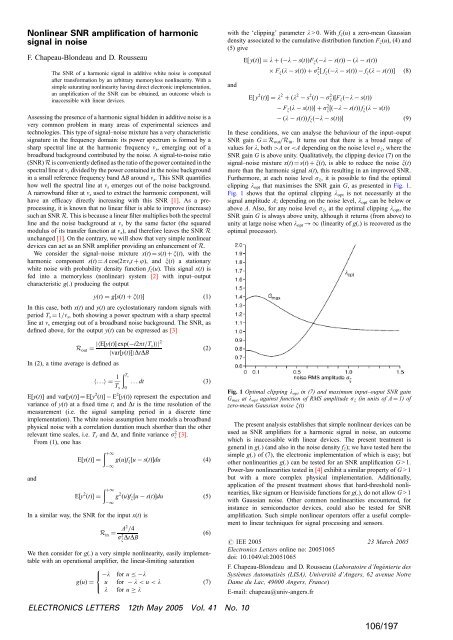a la physique de l'information - Lisa - Université d'Angers
a la physique de l'information - Lisa - Université d'Angers
a la physique de l'information - Lisa - Université d'Angers
Create successful ePaper yourself
Turn your PDF publications into a flip-book with our unique Google optimized e-Paper software.
Nonlinear SNR amplification of harmonic<br />
signal in noise<br />
F. Chapeau-Blon<strong>de</strong>au and D. Rousseau<br />
The SNR of a harmonic signal in additive white noise is computed<br />
after transformation by an arbitrary memoryless nonlinearity. With a<br />
simple saturating nonlinearity having direct electronic implementation,<br />
an amplification of the SNR can be obtained, an outcome which is<br />
inaccessible with linear <strong>de</strong>vices.<br />
Assessing the presence of a harmonic signal hid<strong>de</strong>n in additive noise is a<br />
very common problem in many areas of experimental sciences and<br />
technologies. This type of signal–noise mixture has a very characteristic<br />
signature in the frequency domain: its power spectrum is formed by a<br />
sharp spectral line at the harmonic frequency n s, emerging out of a<br />
broadband background contributed by the noise. A signal-to-noise ratio<br />
(SNR) R is conveniently <strong>de</strong>fined as the ratio of the power contained in the<br />
spectral line at n s divi<strong>de</strong>d by the power contained in the noise background<br />
in a small reference frequency band DB around n s. This SNR quantifies<br />
how well the spectral line at ns emerges out of the noise background.<br />
A narrowband filter at n s used to extract the harmonic component, will<br />
have an efficacy directly increasing with this SNR [1]. As a preprocessing,<br />
it is known that no linear filter is able to improve (increase)<br />
such an SNR R. This is because a linear filter multiplies both the spectral<br />
line and the noise background at n s by the same factor (the squared<br />
modulus of its transfer function at n s), and therefore leaves the SNR R<br />
unchanged [1]. On the contrary, we will show that very simple nonlinear<br />
<strong>de</strong>vices can act as an SNR amplifier providing an enhancement of R.<br />
We consi<strong>de</strong>r the signal–noise mixture x(t) ¼ s(t) þ x(t), with the<br />
harmonic component s(t) ¼ A cos(2pn st þ j), and x(t) a stationary<br />
white noise with probability <strong>de</strong>nsity function f x(u). This signal x(t) is<br />
fed into a memoryless (nonlinear) system [2] with input–output<br />
characteristic g(.) producing the output<br />
yðtÞ ¼g½sðtÞþxðtÞŠ ð1Þ<br />
In this case, both x(t) and y(t) are cyclostationary random signals with<br />
period Ts ¼ 1=ns, both showing a power spectrum with a sharp spectral<br />
line at ns emerging out of a broadband noise background. The SNR, as<br />
<strong>de</strong>fined above, for the output y(t) can be expressed as [3]<br />
Rout ¼ jhE½yðtÞŠ expð i2pt=TsÞij2 hvar½yðtÞŠiDtDB<br />
In (2), a time average is <strong>de</strong>fined as<br />
h...i¼ 1<br />
...dt ð3Þ<br />
Ts 0<br />
E[y(t)] and var[y(t)] ¼ E[y 2 (t)] E 2 [y(t)) represent the expectation and<br />
variance of y(t) at a fixed time t; and Dt is the time resolution of the<br />
measurement (i.e. the signal sampling period in a discrete time<br />
implementation). The white noise assumption here mo<strong>de</strong>ls a broadband<br />
physical noise with a corre<strong>la</strong>tion duration much shorther than the other<br />
2<br />
relevant time scales, i.e. Ts and Dt, and finite variance sx [3].<br />
From (1), one has<br />
and<br />
E½yðtÞŠ ¼<br />
E½y 2 ðtÞŠ ¼<br />
ð þ1<br />
1<br />
ð þ1<br />
1<br />
ð Ts<br />
In a simi<strong>la</strong>r way, the SNR for the input x(t) is<br />
ð2Þ<br />
gðuÞf x½u sðtÞŠdu ð4Þ<br />
g 2 ðuÞf x½u sðtÞŠdu ð5Þ<br />
R in ¼ A2 =4<br />
s 2 x DtDB<br />
We then consi<strong>de</strong>r for g(.) a very simple nonlinearity, easily implementable<br />
with an operational amplifier, the linear-limiting saturation<br />
8<br />
< l for u l<br />
gðuÞ ¼<br />
:<br />
u<br />
l<br />
for<br />
for u<br />
l < u < l<br />
l<br />
ð7Þ<br />
ELECTRONICS LETTERS 12th May 2005 Vol. 41 No. 10<br />
ð6Þ<br />
with the ‘clipping’ parameter l > 0. With f x(u) a zero-mean Gaussian<br />
<strong>de</strong>nsity associated to the cumu<strong>la</strong>tive distribution function F x(u), (4) and<br />
(5) give<br />
and<br />
E½ yðtÞŠ ¼ l þð l sðtÞÞFxð l sðtÞÞ ðl sðtÞÞ<br />
Fxðl sðtÞÞ þ s 2 x½ fxð l sðtÞÞ fxðl sðtÞÞŠ ð8Þ<br />
E½ y 2 ðtÞŠ ¼ l 2 þðl 2<br />
s 2 ðtÞ s 2 xÞ½F xð l sðtÞÞ<br />
F xðl sðtÞÞŠ þ s 2 x½ð l sðtÞÞ f xðl sðtÞÞ<br />
ðl sðtÞÞ f xð l sðtÞÞŠ ð9Þ<br />
In these conditions, we can analyse the behaviour of the input–ouput<br />
SNR gain G ¼R out=R in. It turns out that there is a broad range of<br />
values for l, both >A or 1.<br />
Power-<strong>la</strong>w nonlinearities tested in [4] exhibit a simi<strong>la</strong>r property of G >1<br />
but with a more complex physical implementation. Additionally,<br />
application of the present treatment shows that hard-threshold nonlinearities,<br />
like signum or Heavisi<strong>de</strong> functions for g(.), do not allow G >1<br />
with Gaussian noise. Other common nonlinearities encountered, for<br />
instance in semiconductor <strong>de</strong>vices, could also be tested for SNR<br />
amplification. Such simple nonlinear operators offer a useful complement<br />
to linear techniques for signal processing and sensors.<br />
# IEE 2005 23 March 2005<br />
Electronics Letters online no: 20051065<br />
doi: 10.1049/el:20051065<br />
F. Chapeau-Blon<strong>de</strong>au and D. Rousseau (Laboratoire d’Ingénierie <strong>de</strong>s<br />
Systèmes Automatisés (LISA), <strong>Université</strong> d’Angers, 62 avenue Notre<br />
Dame du Lac, 49000 Angers, France)<br />
E-mail: chapeau@univ-angers.fr<br />
106/197


